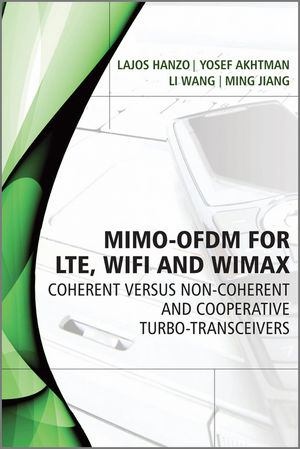MIMO-OFDM for LTE, WiFi and WiMAX: Coherent versus Non-coherent and Cooperative Turbo TransceiversISBN: 978-0-470-68669-0
Hardcover
696 pages
November 2010, Wiley-IEEE Press
 |
||||||
OtherWiley and IEEE Press Books on Related Topics.
Acknowledgments.
Preface.
List of Symbols.
1 Introduction to OFDM and MIMO-OFDM.
1.1 OFDM History.
1.2 OFDM Schematic.
1.3 Channel Estimation for Multicarrier.
1.5 Signal Detection in MIMO-OFDM Systems.
1.6 Iterative Signal Processing for SDM-OFDM.
1.7 System Model.
1.8 SDM-OFDM System Model.
1.9 Novel Aspects and Outline of the Book.
1.10 Chapter Summary.
2 OFDM Standards.
2.1 Wi-Fi.
2.2 3GPP Long-Term Evolution.
2.3 WiMAX Evolution.
2.4 Chapter Summary.
I Coherently Detected SDMA-OFDM Systems.
3 Channel Coding Assisted STBC-OFDM Systems.
3.1 Introduction.
3.2 Space-Time Block Codes.
3.3 Channel Coded Space-Time Block Codes.
3.4 Channel Coding Aided Space-Time Block Coded OFDM.
3.5 Chapter Summary.
4 Coded Modulation Assisted Multi-User SDMA-OFDM Using Frequency-Domain Spreading.
4.1 Introduction.
4.2 System Model.
4.3 Simulation Results.
4.4 Chapter Summary.
5 Hybrid Multi-User Detection for SDMA-OFDM Systems.
5.1 Introduction.
5.2 Genetical Algorithm Assisted Multi-User Detection.
5.3 Enhanced GA-based Multi-User Detection.
5.4 Chapter Summary.
6 DS-Spreading and Slow Subcarrier-Hopping Aided Multi-User SDMA-OFDM Systems.
6.1 Conventional SDMA-OFDM Systems.
6.2 Introduction to Hybrid SDMA-OFDM.
6.3 Subband-Hopping Versus Subcarrier-Hopping.
6.4 System Architecture.
6.5 Simulation Results.
6.6 Complexity Issues.
6.7 Conclusions.
6.8 Chapter Summary.
7 Channel Estimation for OFDM and MC-CDMA.
7.1 Pilot-Assisted Channel Estimation.
7.2 Decision Directed Channel Estimation.
7.3 A Posteriori FD-CTF Estimation.
7.4 A Posteriori CIR Estimation.
7.5 Parametric FS-CIR Estimation.
7.6 Time-Domain A Priori CIR Tap Prediction.
7.7 PASTD Aided DDCE.
7.8 Channel Estimation for MIMO-OFDM.
8 Iterative Joint Channel Estimation and MUD for SDMA-OFDM Systems.
8.1 Introduction.
8.2 System Overview.
8.3 GA-assisted Iterative Joint Channel Estimation and MUD.
8.4 Simulation Results.
8.5 Conclusions.
8.6 Chapter Summary.
II Coherent versus Non-Coherent and Cooperative OFDM Systems List of Symbols in Part II.
9 Reduced-Complexity Sphere Detection for Uncoded SDMA-OFDM Systems.
9.1 Introduction.
9.2 Principle of Sphere Detection.
9.3 Complexity-Reduction Schemes for SD.
9.4 Comparison of the Depth-First, K-Best and OHRSA Detectors.
9.5 Chapter Conclusions.
10 Reduced-Complexity Iterative Sphere Detection for Channel Coded SDMA-OFDM Systems.
10.1 Introduction.
10.2 Channel Coded Iterative Center-Shifting SD.
10.3 Apriori-LLR-Threshold-Assisted Low-Complexity SD.
10.4 Unity-Rate-Code-Aided Three-Stage Iterative Receiver Employing SD.
10.5 Chapter Conclusions.
11 Sphere Packing Modulated STBC-OFDM and its Sphere Detection.
11.1 Introduction.
11.2 Orthogonal Transmit Diversity Design with Sphere Packing Modulation.
11.3 Sphere Detection Design for Sphere Packing Modulation.
11.4 Chapter Conclusions.
12 Multiple-Symbol Differential Sphere Detection for Cooperative OFDM.
12.1 Introduction.
12.2 Principle of Single-Path Multiple-Symbol Differential Sphere Detection.
12.3 Multi-Path MSDSD Design for Cooperative Communication.
12.4 Chapter Conclusions.
13 Resource Allocation for the DifferentiallyModulated Cooperative Uplink.
13.1 Introduction.
13.2 Performance Analysis of the Cooperation-Aided Uplink.
13.3 Cooperating-User-Selection for the Uplink.
13.4 Joint CPS and CUS for the Differential Cooperative Cellular Uplink Using APC.
13.5 Chapter Conclusions.
14 The Near-Capacity DifferentiallyModulated Cooperative Cellular Uplink.
14.1 Introduction.
14.2 Channel Capacity of Non-coherent Detectors.
14.3 Soft-Input Soft-OutputMSDSD.
14.4 Approaching the Capacity of the Differentially Modulated Cooperative Cellular Uplink .
14.5 Chapter Conclusions.
III Coherent SDM-OFDM Systems.
15 Multi-Stream Detection for SDM-OFDM Systems.
15.1 SDM/V-BLAST OFDM Architecture.
15.2 Linear Detection Methods.
15.3 Non-Linear SDM Detection Methods.
15.4 Performance Enhancement Using Space-Frequency Interleaving.
15.5 Performance Comparison and Discussion.
15.6 Conclusions.
16 Approximate Log-MAP SDM-OFDM Multi-Stream Detection.
16.1 Optimized Hierarchy Reduced Search Algorithm-Aided SDM Detection.
17 Iterative Channel Estimation and Multi-Stream Detection for SDM-OFDM.
17.1 Iterative Signal Processing.
17.2 Turbo Forward Error Correction Coding.
17.3 Iterative Detection – Decoding.
17.4 Iterative Channel Estimation – Detection – Decoding.
18 Summary, Conclusions and Future Research.
18.1 Summary of the Results.
18.2 Suggestions for Future Research.
A Appendix to Chapter 5.
A.1 A Brief Introduction to Genetic Algorithms.
A.2 Normalization of the Mutation-Induced Transition Probability.
Glossary.
Bibliography.
Subject Index.
Author Index.



